NORTH DAKOTA RECAP: Wait, Is This Team Just Bad??
A second-straight uninspiring performance has the Huskers needing to answer some questions
After Nebraska blew a game against Northwestern in nightmare-inducing fashion to open the season, I think fans were ready for the Huskers to come out and drop the PEOPLE’S ELBOW on a pretty mediocre FCS team in Game Two.
Instead … NU was tied 7-7 with North Dakota at halftime.
While the final score of 38-17 did end up being a bit of a laugher, Nebraska having tight moments well into the fourth quarter of this game was not something anybody really expected or should be happy about.
After perusing some message boards, I feel like the biggest question/fear on Husker Nation’s mind after two games is, simply, “Wait, is this team just bad???” After losing to Northwestern and playing tight with the team picked seventh in the Missouri Valley Conference preseason poll, several people are screaming “YES!” at their computer screens right now. I get it; I know I was certainly screaming things at my screens Saturday.
With that in mind — in addition to the usual numbers and breakdown — I wanted to see if there was a more nuanced answer to that question in the numbers or film that might either (a) give us all some hope for the rest of the year or (b) allow us to all just strap in for the season from hell. I’ve weaved in some bullet points in the sections of things that I think are promising for the future and some things I think are some major red-alarms. Thanks, as always, for reading.
PROGRAMMING NOTES: If you were tuned out for the offseason or are a new subscriber, I would suggest reading the post detailing the newsletter’s plan for this year; it will better explain what things like success rate are and why the changes happened. For the first few weeks of the season, I’ll be comparing this week’s game’s data to the previous week’s game’s, until we get a sample size big enough to function as season-long data.
OFFENSE
GAME CHART
OVERALL
If you looked at these numbers without having watched the game, you’d say, “Wow, pretty good!” The 3.45 points per drive is the highest NU has had in a game since I started this newsletter last season, and the 6.83 yards per play would have finished 7th nationally last year. These are more or less what you’d like to see NU do against an overmatched FCS team.
But we all watched the game, and I, personally, didn’t get the vibe that the offense was rolling. Part of that is because the yardage came on a handful of big plays — the per-down success rate of 53% is kind of an iffy data point here. But I also think this indicates that UND’s hold-the-ball-to-limit-possessions (and Nebraska’s defense’s inability to get the UND offense off the field) is skewing how we are perceiving the Nebraska offense’s performance in this game, just a bit. The Huskers only got four meaningful offensive possessions in the first half — they scored easily on one, got in the red zone on another (and missed a field goal), and had their other two derailed by sacks (including a lost fumble). Normally, getting in scoring position on half your possessions would be … fine. But the defense can’t tackle, and suddenly the narrative is the offense only put up 7 points at halftime against an FCS team.
— Reason For Optimism: The offense is probably better than it’s looked aesthetically. If you view things on a per-play basis, this has been a top 30-ish type of offense while breaking in a new quarterback and group of receivers with a new scheme and coaching staff. Beyond just success rates or yards per play, NU is 36th in Expected Points Added Per Pass and 33rd in Expected Points Added Per Run. That’s a good, well-balanced offense. And there’s reason to think it may get better than that: (a) Some things with the new scheme and chemistry between players still seem glitchy — I’m thinking of Thompson, one of the better deep passers in the country last year, whiffing a couple easy deep touchdowns in two games to transfer receivers — which will likely improve with practice and game reps and as the rotation shrinks; and (b) Nebraska’s average starting field position is currently ranked 124th nationally, which is pretty luck dependent and likely to regress to the mean. Both of those things improve beyond a two-game sample size, which I think is pretty possible, and we’ll all feel better about the offense.
Not a ton different here from last week, although we did see a significant increase in RPO usage and fewer straightforward “pro-style” formational looks — probably a good thing for now based on how tepid the results have been from the new I-Formation package. We also saw a pretty dramatic increase in quads usage, although that number may be a little artificially skewed by NU running variations of unbalanced quads look on eight of its last 10 plays as it ran the ball down UND’s throat.
RUNNING GAME
NU consolidated its running game a bit vs. UND, and had a lot of success just running up the middle — NU ran Inside Zone or Duo (plays designed to hit interior gaps) on 26 of its 40 plays with a rushing element and was “successful” on 18 of them. Of NU’s five runs that gained 12 or more yards Saturday, four came on these concepts, with the fifth coming on a Split Zone look (also intentioned to be an inside-hitting play.)
I still think what Nebraska wants its running game to be is a bit fluid and developing, both as Scott Frost and Mark Whipple continue to meld their offensive concepts and as a mostly-new offensive line gels. I think we’re gonna see some pretty high variance in this, and I’m not putting too much stock into these percentages for a bit.
— A Reason For Pessimism: Nebraska’s offensive line has struggled to get much push on the ground and has largely found success because Anthony Grant has played like an all-conference caliber back (which I sorta called btw, not bragging, OK, YES, I ABSOLUTELY AM BRAGGING). The line looked better in the second half vs. UND, but if it isn’t improving, some of those bigger runs are going to dry up against better competition.
A COOL PLAY
Nebraska displayed an interesting variation on what looks like a counter concept:
This play is out of 13 personnel, meaning one back and three tight ends. Two tight ends are attached to the formation at the top of the screen, with the third, Chancellor Brewington, split out as the No. 1 off the ball at the bottom of the screen. Omar Manning, a bigger receiver who very well might pass as a tight end, is the No. 2 receiver condensed tight to the formation. Both of these players are going cross the formation on lead blocks like in a counter play.
Brewington comes in Jet motion at the snap, and leads up to clean up the backside end man on the line of scrimmage before getting to the next level. Manning follows right behind into the hole and smacks the Mike linebacker. NU’s offensive line actually gets three double teams on this play on the down defensive linemen and completely collapses the UND defensive line:
I’ve … never seen anything like this? I’m calling it XF Counter because the pullers are the F (third tight end) and X receivers. NU ran this play three times and also threw a play action pass out of the same formation. Would love to get some more information on it if anyone has some!
PASSING GAME
PLAY-ACTION IS BACK. Whipple heard my complaining about NU’s lack of play-action use in its first game and CRANKED that dial up to using it on nearly 61% of NU’s true drop backs … and then it barely worked. Owned. A couple of those I charted were missed throws and a couple more were receiver drops, so the success rate overall is a bit negatively skewed. If you notice in the numbers, Nebraska’s overall play-action success rate was lower overall than when it’s success rate when it pulled a lineman for protection — meaning the play-action looks with a puller, which more closely emulate an actual run concept than just the token fake to the running back looks, were more effective and were affecting the linebackers.
We also saw our first two screen attempts of the season Saturday — one to missing person Rahmir Johnson — that both looked deeply out of sync. The first screen attempt to Rahmir in the first quarter looked as if it would have gained some big yards had the throw been better, but one of the linemen didn’t get their defender’s hands down and Thompson had to loft the ball over Rahmir’s head.
— Reason for Pessimism: Nebraska continues to want to operate with five-man pass protections almost all of the time but isn’t getting good plays from it’s tackles. I had some belief the pass protection might improve with another year of development, but Bryce Benhart on the right side and Teddy Prochazka on the left have gotten beaten around the edge repeatedly by players from two not-particularly-fearsome fronts. NU hasn’t paid much for it because Thompson is good at operating in the pocket and gets the ball out quickly, but that may not be enough against the better defenses the Huskers are likely to see later in the season. That could lead to more negative plays — sacks, pressures that lead to turnovers — or it could make NU have to keep more guys into protect, which means fewer eligible receivers getting out in routes on pure passing plays.
Nebraska only ran 22 true drop back pass plays — not including RPOs and screens — on Saturday, a handful of which I couldn’t see the route combos on because of the broadcast TV camera zoom. But I am going to try to chart from here on out what passing concepts NU is using, but again … I can’t always see what’s happening downfield and am having to guess a bit, so don’t take these as gospel.
UND was running Cover 3 on the vast majority of its snaps, so you’re seeing a lot of concepts here that flood deeper areas of zones to the outside of the formation and can get people open up the seams. As we get more data than one game, I’ll try to break down what some of the more popular concepts look like.
Overall, I think the fans’ general vibe with the passing game was that Thompson struggled much more than in his pretty solid debut vs. Northwestern. It wasn’t really that bad — he completed 66 percent of his passes for 9.19 yards an attempt — but it generally seemed as if he wasn’t processing things as quickly or getting the ball out as fast. One reason I saw was a variety of sim pressures and junk defenses from UND on early downs.
A sim pressure is as simple as its name — it’s just a “simulated pressure”; the defense bluffs pre-snap as if it’s going to bring extra rushers, but ultimately drops them into coverage while bringing rushers from places it didn’t appear it was going to pre-snap. That doesn’t sound complex, but it completely melts quarterbacks’ and offensive line’s brains.
In the play above, UND looks as if it may bring five rushers presnap — the three down linemen, plus the two players lined up on the edges. The edge to the boundary is likely to drop to cover the No. 2 receiver (Thompson can’t know that for sure pre-snap and has to check, but it’s a likely guess), but the edge to the field seems likely to be coming.
Four guys DO end up rushing the QB, the three down lineman … plus the Mike linebacker, who pre-snap looked sure to drop into coverage. Both edges drop out into the hook/curl zone.
UND only brings four rushers, so it’s not really a blitz, but the confusion it creates can serve the same effect as a blitz. It doesn’t help NU is lined up in its goofy formation here with the tight end lined up where the left tackle usually is.
UND brought these a ton on early downs, introducing some chaos to the NU gameplan. Sim pressures can be hell on a quarterback to process — especially one playing in a new system and and who may not be totally in-sync with his new teammates or hot reads yet. But they also leave you very vulnerable in your run fits, which is why most teams don’t do them on early downs and reserve them for passing situations or pressure packages. By the middle of the fourth quarter, the Nebraska offensive brain trust had realized what was happening and just started overloading one side of the line with Quads formations and running the ball for massive chunks (see the Quads success rate above).
This element of the game felt very “underdog has months to prepare for a game and throws some goofy stuff against the wall in an effort to hope for a mistake.” Which did happen, until NU eventually realized it could just run North Dakota over and di.
Play CallerGate
Husker media was ABUZZ after Frost gave a non-answer to a question asking who was calling offensive plays in the second half of the game, when NU found its rhythm.
I think one of the biggest misconceptions casual fans have is of coordinators being these solo auteurs who are creating these brilliant works of art on their own, when play-calling on either side of the ball is a actually deeply collaborative process among an entire staff.
Staffs develop lists of plays during the week well in advance of the game being played (i.e. “I like these five plays on first down against an under front;” “I like these three plays on 3rd and short;” etc.) and discuss them with players in meetings, adding or subtracting as the players feel comfortable of uncomfortable, and then focus on repping that shortened list during the week’s practices. During the game, coaches are constantly asking and offering feedback to the primary play-caller. At the junior college I coached at, the offensive coordinator would often ask the offensive line coach (who is more closely watching the trenches and talking to the offensive linemen about what they’re seeing between series) things such as “I want a running play here; what concepts do you like right now?” and the offensive line coach would more or less be the “play caller” of that the run play. So it’s almost never just one guy pulling a string by himself.
Nebraska definitely did run some more Frost-esque stuff in the second half Saturday, but the conversation was probably more akin to suggestions of some stuff that worked last year, with Whipple agreeing, than some full-scale mutiny play-calling takeover as some have painted it as. This is probably just a storm in a teacup and good radio fodder for the week but not ultimately important.
DEFENSE
GAME CHART
OVERALL
For the second-straight game, Nebraska was again pretty solid on a per-play basis while brain-melting in key moments to sink the entire enterprise. North Dakota only had five of its 68 total play go for longer than 10 yards but seemed to just get 3-5 yards every down — their quarterback finished with 37 attempts for just 131 yards.
Some of that is just the structure of the the Huskers’ defense; NU plays a lot of two-high shells, which means light boxes for offenses to run on, and Cover 4, which leaves you open to underneath passes. This strategy does ostensibly prevent big passing plays, but it also leaves you open to getting papercut down the field. The hope is that most college quarterbacks will not be competent enough to string together many 10+-play drives without getting behind the chains or making a mistake, but in two games, Northwestern and North Dakota mostly have done just that.
— Reason For Optimism: There’s probably some positive regression due on teams putting together long drives against Nebraska’s defense, specifically on long third downs. Northwestern and North Dakota faced a combined seven 3rd and 9s or longer against Nebraska and has converted five of them. Some of that is the pass rush not getting home vs. Northwestern, but unless we think those two teams have historically good offenses or Nebraska has a historically bad defense, teams will probably not keep converting those at a ~70% rate. And the pass rush was a lot better against UND — it just only resulted in a couple of sacks because the ball was coming out so fast and short and the UND quarterback was mobile.
But a bigger third down issue is that Northwestern and North Dakota only faced a combined seven third and 9+ against Nebraska, largely because of continued poor interior run defense, tackling, and alignment by the Blackshirts that allowed them to get good yardage on early downs to set up third and shorts.
I’m specifically appalled by the tackling so far. Nebraska missed a bunch of tackles against Northwestern that led to big plays, and then followed that up by missing three tackles on its first drive vs. North Dakota. Overall, I had NU missing seven tackles Saturday for a total of 58 yards, with several being likely tackles for loss. It may not seem like a lot, but there’s a big difference in your defensive approach and chances of getting off the field between a 2nd and 12 and a 2nd and 6. The culprit this time seemed to at least be new guys, with true freshman Ernest Hausmann (starting at Mike linebacker with Nick Henrich injured) missing at least three of the tackles.
And that figure’s not even to count extra yards that are coming from guys starting out of position in the first place or making mental mistakes. On UND’s biggest play, the long run in the third quarter, Nebraska runs a boundary safety blitz right into the play.
With the blitz rules, the safety, Myles Farmer, has outside contain — no run should get outside him.
He should pinch the running back back inside to his help for a no gain or 1-yard gain. But Farmer lets the quarterback’s fake suck him outside and the back run right by him.
The three new starters in the secondary also just seem to be struggling to communicate and get lined up:
Nebraska is checking to a blitz here because UND came out in and Empty formation, and the Huskers are switching the coverage to Cover 1. The secondary players at the top of the screen are trying to signal to Hausmann to cover the No. 3 to that side so that the safety to the field can drop into a deep middle zone, and linebacker Luke Reimer at the hash on the bottom of the screen is trying to indicate to the boundary safety that he needs to take over his man coverage responsibility on the No. 2 receiver so that Reimer can blitz. These sort of wild struggles to get lined up have been uncomfortably common in both games and are leading to a lot of big plays.
Reason for Pessimism — I think the alignment/inexperience/communication stuff will get fixed with more game reps, but what if it takes six games and the defense still struggles this badly? Most of the Huskers’ winnable games now seem in that stretch. And on tackling — I was willing to give the D the benefit of the doubt on it last week because NU was a very good tackling team last year, but two weeks makes a trend. This has been Northwestern and North Dakota. If this doesn’t get fixed, what are the skill guys from OU or Michigan going to do? Yikes. The third-down problems were also present last year, so what if it’s just a weakness of NU’s fairly vanilla defensive scheme?
Not a whole lot to report here that was different, other than NU cranking up the man coverages a bit and dialing back the blitzes, likely because Nebraska’s staff felt its defensive backs could hold up in one-on-one coverage and get pressure with four against UND’s skill players, which had some mixed results, as we saw with the bevy of short passes.
Some of the defense’s struggles have been that coordinator Erik Chinander has been pretty vanilla through two games, likely because the inexperience of the new starters is preventing him from getting too exotic. Which is partially causing some of the long 3rd down struggles. In good news, I noticed NU was rotating in defensive linemen a lot more, especially in the first half.
We also got our first look at the Blackshirts’ Dime package; “Dime” personnel is just a defensive structure that subs out two linebackers from a base defense to get six secondary players on the field. Nebraska’s Dime package also has a fun wrinkle of getting their three elite pass rushers on the field at the same time in Garrett Nelson, Ochaun Mathis, and Caleb Tannor:
Tannor was sort of a hybrid player on the snaps they ran Dime, blitzing on a couple, dropping on a couple and playing a spy on a couple. Nebraska’s Dime safety appears to be former walk-on and testing-number god Phalen Sanford.
Whew. Two games, two kinda gross performances. I’ve provided some reasons to be excited and some reasons to be worried; I’ll leave it to you to decide what you want to take away. Here’s to hoping for a more well-rounded effort tomorrow. Thanks as always for reading, and GO BIG RED.
Comments are open for discussion or questions, and I’ll do my best to respond.


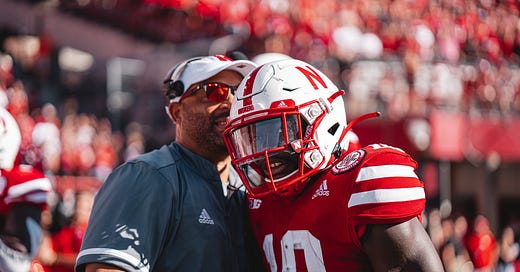







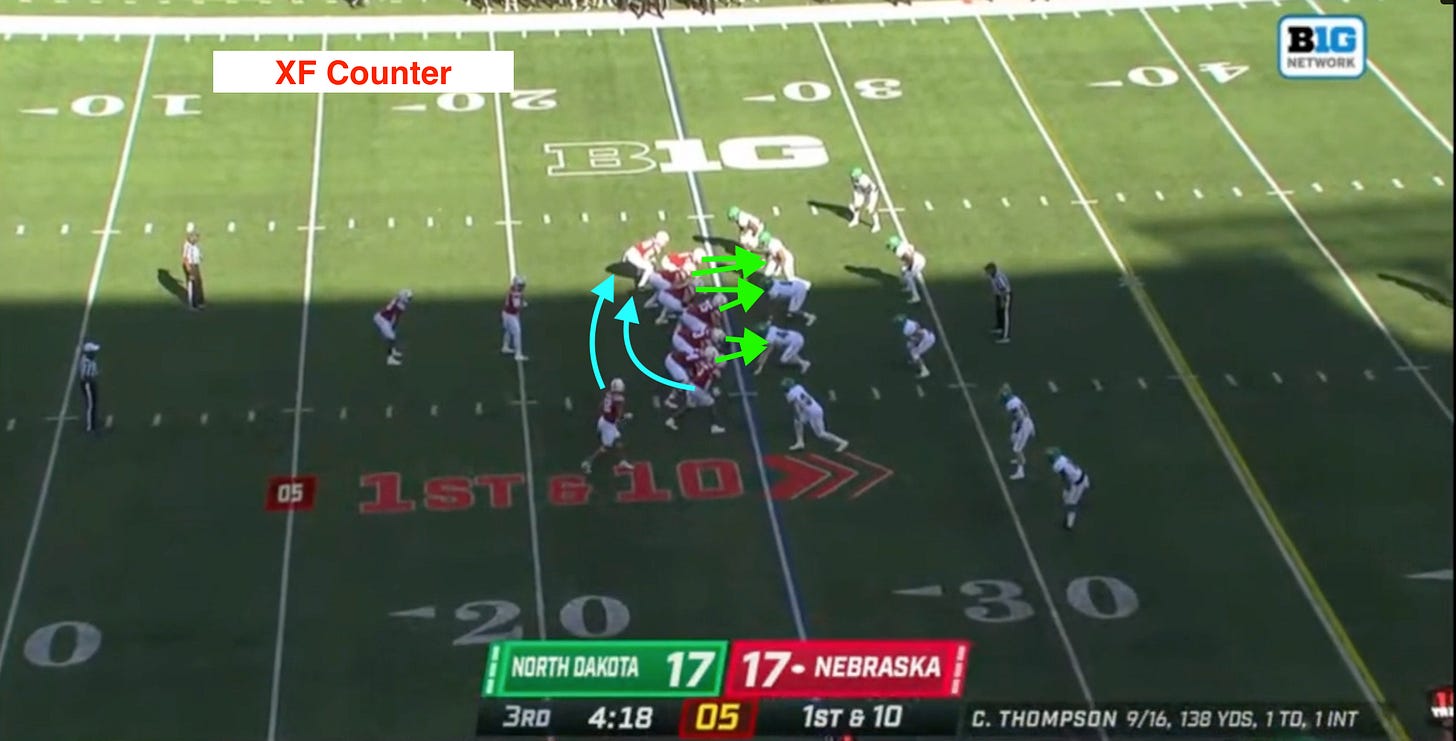

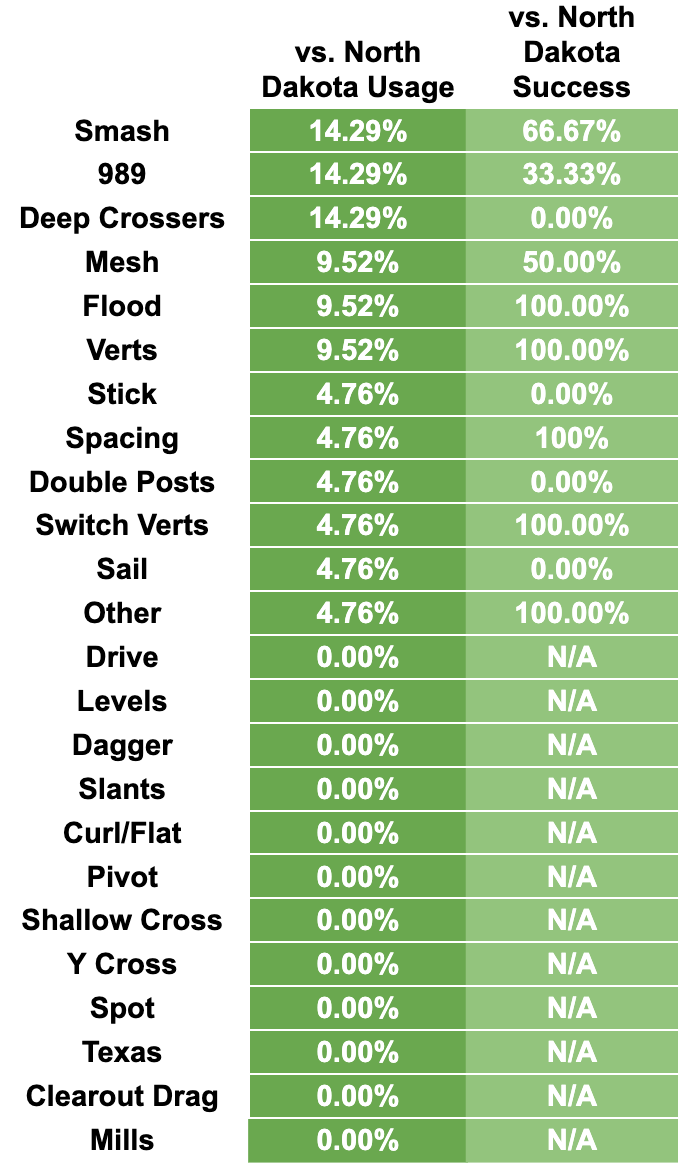
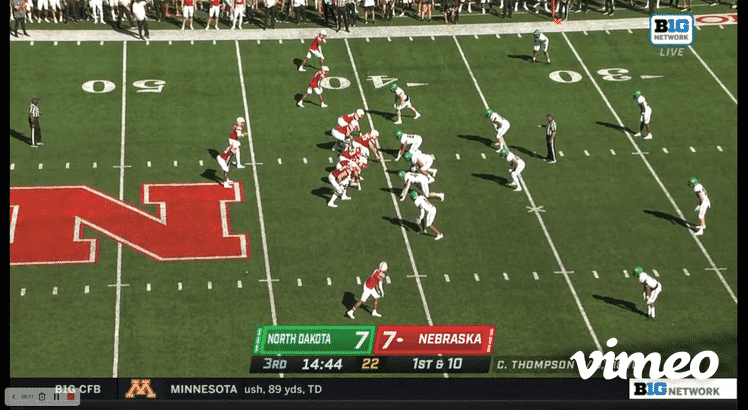





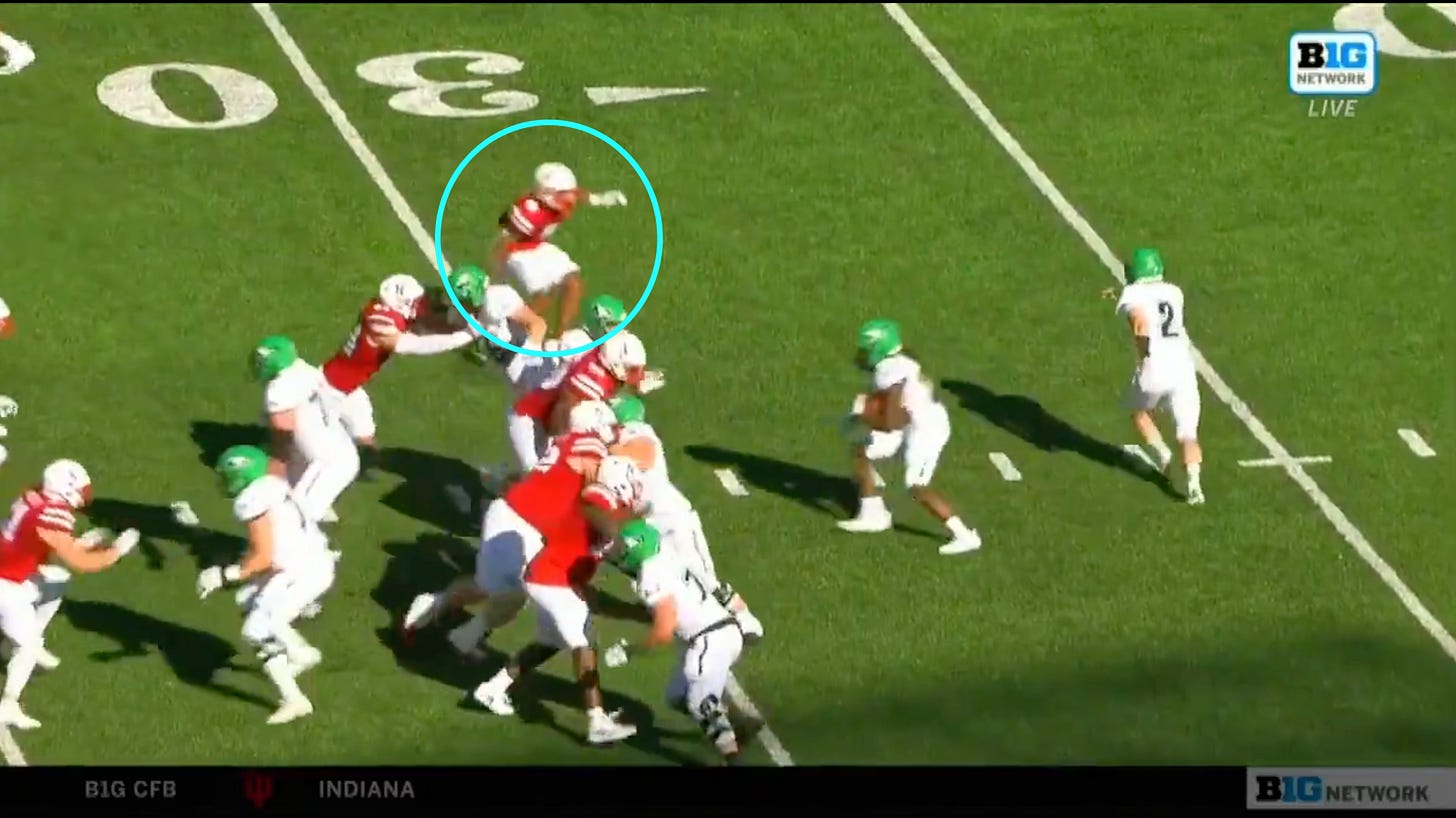
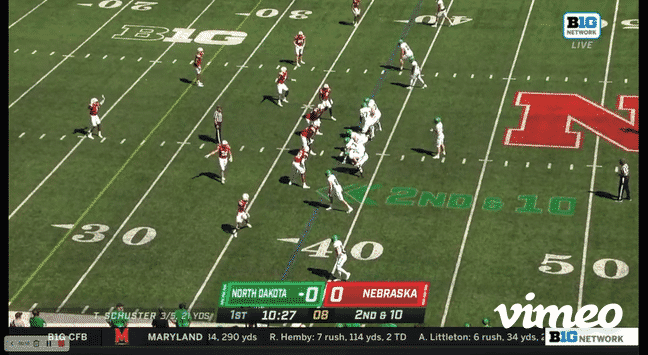


The WR counter play comes from Sean McVay’s playbook I believe. I know Frost mentioned in a recent press conference about using plays from the Rams. I don’t remember the exact quote though. Here’s a YouTube video I found that breaks down the play:
https://youtu.be/MYaajrXN2nM
I love this newsletter! I learn something new about the game every time a new one comes out. Thank you for the time and effort you put in!